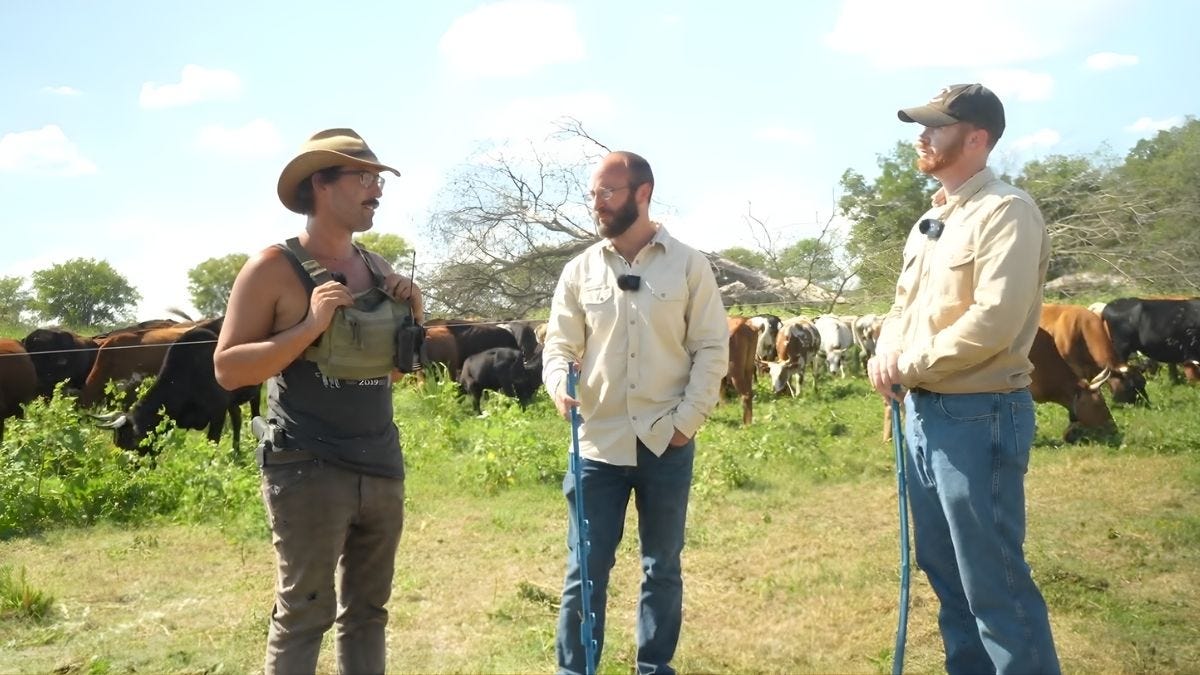From Beeps to Beef: What a 5-Move Day at Smoke River Ranch Teaches About Regenerating Grasslands
How five-a-day mob moves, virtual fencing, and “zombie-apocalypse” cattle are reviving pasture, profit, and rural culture in the Great Plains.

Quick facts (what you’ll learn)
Where: Smoke River Ranch, Northeast Oklahoma
What: Ultra-high-density, non-selective grazing; 4–6 cattle moves/day; 600k–800k lbs/acre stocking density (with calves)
How: Transitioning from physical polywire to virtual fencing for ~60 labor hours saved weekly
Why it matters: More complete forage utilization, longer rest periods, faster succession toward diverse, palatable species, and measurable soil recovery
Who: Ranch founder Joel; herd manager Daniel; new team member David (ex-PhD plant biologist turned regenerative rancher); FreshRX Oklahoma’s Erin connecting food to health outcomes
When the Pasture Started Breathing
Oklahoma heat shimmered off the grass as 500 heads of cattle tightened into a moving wall. Joel stood with a tablet in one hand, a GPS fence map glowing on-screen.
One tap (a beep, then another) and the herd began its FIFTH move of the day.
Ryan watched the hooves churn the soil. “It’s like the ground’s exhaling,” he said.
Joel smiled. “That’s the idea. Bison used to do this — we’re just trying to remember how.”
From Twitter DMs to a Ranch in Oklahoma
Two years earlier, Joel had tweeted an open invitation: “If you really want to build soil, come help.”
David, then finishing a PhD in plant biology, replied half-jokingly from Mexico. Three months later he arrived, leaving behind the university labs for hoofprints and hay.
He joined Joel’s experiment to prove that high-density, low-input cattle could restore the land faster than chemicals or cover crops ever had.
And that people could be restored alongside it.
Why Intensity Is the Point
Conventional grazing lets cows pick their favorite plants, leaving behind the rough and weedy. Joel’s herd doesn’t get that luxury. They’re packed tight (600 000 to 800 000 pounds of animal per acre) and moved four to six times daily.
The pressure mimics ancient bison herds: hooves trampling litter, manure evenly spread, seeds pressed into soil cups that catch the next rain.
The land rests for weeks, sometimes months, before another pass.
That cycle builds carbon belowground and resilience above it.
“If you let cows cherry-pick, you get monoculture,” Joel said. “If you make them eat everything, you get diversity — and profit.”
Miracles Take Hard Work
In the ranch house kitchen, Erin — founder of Fresh RX Oklahoma — was portioning beef and vegetables for prescription meal kits.
Doctors in the program write “food scripts” for patients with type-2 diabetes; Erin fills them with local regenerative beef and produce. The data already show drops in medication use.
Outside, Daniel, the herd manager, radioed: “Rumen fill looks good, 80 percent full. Move six in fifteen.”
Science and stewardship, kitchen and pasture, it all pulsed on the same clock.
Field Notes from the Pasture
1. Ultra-High-Density Grazing (“Mob Moves”)
Target 600–800 K lbs per acre at each move.
Short graze, long rest: prevents cows from biting regrowth “candy shoots.”
Results: 3–4× more beef per acre than conventional rotation + faster soil recovery.
2. Virtual Fencing = Time as Profit
Gallagher GPS collars replace miles of poly-wire. Draw digital paddocks on a screen; collars beep or block boundaries.
~60 labor hours/week saved → reinvested into observation and animal metrics.
3. Breeding for Thrift (“Zombie-Apocalypse Cows”)
Base herd: Pineywoods — small, parasite-resistant, disease-hardy.
Composite bulls (Machona, Obrac, Red Angus crosses) add stamina and meat quality.
Selection rules:
Breed by 15 months, calve before 2, again before 3.
Wean two calves at 50 % of body weight each.
Any cow needing constant help → cull and finish for beef.
4. Metrics That Matter
Rumen fill check (look left flank) 2×/day = feed sufficiency.
Manure score: runny = too much protein; stacked = too little.
Timid-cow test: paddock is as small as the shyest cow still enters comfortably.
The Bigger Pattern: Soil ↔ Cattle ↔ People
Rural America’s decline is not just economic — it’s biological.
When food loses nutrients, bodies suffer; when people suffer, communities fracture.
Smoke River Ranch and Fresh RX Oklahoma are stitching that loop back together: healthy soils grow healthy food that funds healthy families.
Thanks for reading & please consider becoming a paid subsciber to support more farm tours like this one. Viva La Regenaissance!
-Ryan Griggs, The Regenaissance Founder
Watch The Tour
🎥 Cows Can Rebuild Our Soil & Society — full Farm Tour at Smoke River Ranch (Oklahoma)
Takeaways for Regenerative Curious Farmers
Intensity + rest is the engine: complete graze now → diversity later → more cattle per acre overall.
Time is profit: virtual fencing converts fence labor into observation and stockmanship.
Select for thrift: fertility under pressure, feet, lungs, parasite resistance — not just frame.
Health is a loop: food-as-medicine programs create stable demand for nutrient-dense beef.

